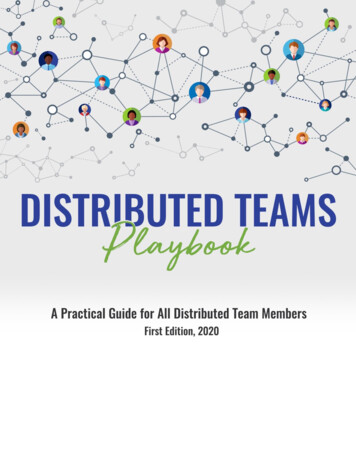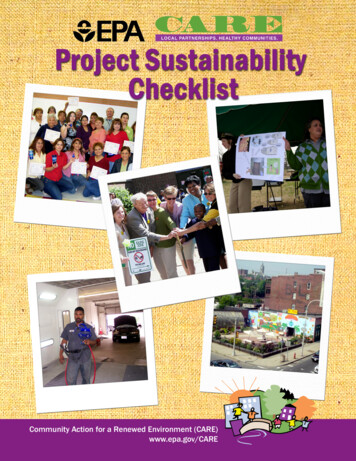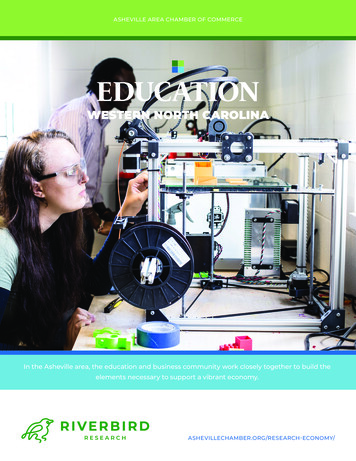
Transcription
1
Building and Sustaining a Strong Distributed Team at the State of Missouri . 4Culture is critical to the success of all teams . 4Know Your Role . 4Learn and Grow . 5Commit to the Team . 7Live the Mission . 10Policy Considerations and Planning. 12Position Eligibility/Technology Profiles . 12Team Member Suitability. 14Supplies and Equipment . 15Security of Information and Record Retention . 15Legal Compliance . 16Flexible Work Schedules . 17Budget Considerations and Planning . 17Space Savings May Be Available to Offset Technology Investments . 19Existing Funds that can be used to Support Distributed Work Costs . 20New Funds to Cover Increased Distributed Costs . 20Technology Considerations and Planning . 20Procurement Procedures for End User IT Equipment . 20Equipment . 24Space Considerations and Planning . 26Hoteling . 27Collaboration Areas . 28Glossary . 282
“As your organization disperses , the loss of personal interactions willquickly sink in All of us learn by watching our teammates, and we gainconfidence through informal feedback from our colleagues or bosses Youmust immediately take your culture online, and learn to reinforcecamaraderie, esteem and compassion, via digital platforms.”–Gen. Stanley McChrystal (“What 9/11 Taught Us About Leadership in a Crisis.”)The State of Missouri is committed to recruiting and retaining top team members. According to the U.S.Bureau of Labor Statistics, the population of workers working in a space other than an office hasdoubled since March 2020. Across numerous industries the majority of team members who work indistributed teams at least part-time report increased job satisfaction, miss work less often, and are lesslikely to leave the employer. In order for the State of Missouri to remain competitive in this evolvingwork environment, expanding and formalizing our distributed work team environment is essential. Todo this in a sustainable way, each department has developed a distributed team or alternative workenvironment policy. In addition, this Distributed Team Playbook was developed by over 100 teammembers across all 16 executive agencies.These policies establish minimum operating standards and expectations for team members in adistributed work team environment.This State of Missouri Distributed Work Teams Playbook (“Playbook”) serves to help leaders and teammembers operate most effectively in a distributed environment. The playbook is supported with dozensof ancillary documents and a distributed work team website that the Office of Administration (OA) willmaintain.A distributed team is a group of team members who get work done in different physical spaces. Teammembers may work in an institution, a warehouse, from a vehicle, or in their home. The State ofMissouri (hereinafter, “the State”) has been supporting some distributed teams for years. This playbookis intended to help all departments transition to and sustain this new normal. It will help leaders andteam members navigate the challenges and opportunities of working in a distributed team.Distributed teams are all team members, not just those team members working outside the officesetting. This playbook speaks to all members of every team no matter where they accomplish theirwork. The efforts required for a team to be successful are the efforts of every member of the team.Challenges inherent in every team can be magnified in distributed teams. Challenges in communication,culture and coordination are common. This playbook provides tips and tools to help teams overcomethese issues in positive and productive ways together.This playbook should be used as a guide to get started in the new normal of distributed teams. It shouldalso be used as a reference going forward as state teams face the challenges that arise in any largeorganization. The playbook is organized into five interdependent focus areas that are all critical to thesuccess of this new normal.3
Use this as a tool and roadmap to implementation and sustainment of distributed teams. Many of thetopics in this playbook are not novel; instead, they are best practices that all team members need to bereminded of in any work environment. Throughout the playbook there are terms that may be new;please reference the glossary to learn more.Building and Sustaining a Strong Distributed Team at the State of MissouriTo be successful in a sustained distributed environment, team members and leaders must be dedicatedto developing and fostering a culture that supports distributed teams. All teams should be inclusive ofeach team member, regardless of location. A strong workplace culture is more challenging in adistributed environment, but not impossible. Peter Drucker, a management guru, coined the phrase“Culture Eats Strategy for Breakfast.” He highlighted why getting team culture right is the mostimportant step in ensuring we are successful in our new normal. This section will guide teams regardingculture and best practices to ensure team members have the tools and technology to be successful andgrow together.Culture is critical to the success of all teamsA positive distributed work culture exists when teammates share similar priorities, interests, andattitudes. If a strong work culture exists, important connections survive even if people do not see eachother on a regular basis. Strong work cultures give people an important sense of belonging. The Stateseeks to build and reinforce our desired team culture using the ENGAGE 2.0 Growth Model. Aspects ofthe Growth Model and how to leverage this approach in our team work are discussed below.Figure 1: The Growth Model - State of Missouri 20204
Every team member in a distributed work environment has an important role to play in the success ofthe team. Over time, individuals may play different roles on the team. Sometimes, team members areasked to lead; sometimes, team members are asked to be in a support role. Successful teams depend onconnectedness, cohesion and trust.Leaders should continually strive to create an environment where a healthy culture can thrive using thebelow suggestions: Be a consistent communicator.Set a fair playing field for all.Set clear expectations for all team members. The work is the work no matter where it gets done.Emphasize quality in each task.Begin with the end in mind: clarify the goals and link them to organizational priorities.Understand the culture of the team by getting to know each team member.Keep team members informed.Provide a platform for effective communication for the whole team.Recognize great work. Celebrate often!Facilitate regular team building activities.Have empathy.Be authentic.Be inclusive.All team members should work to create a positive team culture by: Asking questions or making recommendations to improve team success.Assuming positive intent."Showing up" to meetings and be heard – contributing in meetings, regardless of platform.During team video conferences, using the video feature when possible to make a humanconnection.Participating in team communications using all platforms.Being dependable.5
How to Onboard SuccessfullyOnboarding new team members can be challenging at any time, but especially when teams aredistributed. Hiring leaders need to focus on ensuring that a new team member feels as welcome aspossible. The best way to ensure that new team members adapt to organizational culture is by settingthe tone very quickly at the beginning.One of the most vital and challenging responsibilities for an organization is to recruit the right talent. Anorganization must also find effective ways to retain and engage team members. Team members mayread about, and have an appreciation of, the mission and values, but they will need assistance inunderstanding the unwritten rules, values and cultural norms within the organization. Onboarding is avital first step, particularly within a distributed team. Onboarding goes beyond making sure a teammember’s “new hire” paperwork is completed in a timely manner. When a successful onboardingstrategy has been created for your team, turn it into a checklist that you can use going forward. Acollection of sample resources are available to build from here.Here are some tips for successfully onboarding a new team member: Begin onboarding prior to the new member’s arrival by getting their work space prepared, allequipment ordered, and any accesses they will need done before they start. The Office ofAdministration is working to build many of these preparation steps into the current MoCareershiring platform.Update the existing team to let them know that a new team member will be starting, what daythey will be starting, and what the current team members’ expectations are. By preparing aheadof time, new team members will be stepping into an organized and welcoming environment.This saves time, provides a positive first impression and provides easy access to the tools andinformation needed to get started.Encourage a growth mindset, with professional development opportunities and definedexpectations.Provide context when giving directions. Include the “why” while educating on the “how.”Ensure that every new team member knows exactly what is expected of them, how they can beproductive and that they are already a necessary part of their new team.Ensure that every new team member has the tools for success including training resources.Onboarding goes beyond the first day. For onboarding to be successful, use milestones such as30, 90, 180 and 365 days on the job to facilitate experiences and check in with the teammember. The Division of Personnel in the Office of Administration coordinates automaticsurveys to new team members at regular intervals to gauge and learn from their experiences.Results are available at the division and department level to help improve onboarding practices.Create a buddy program to assist the new team member in acclimating to their role and answerquestions.6
Buddy ProgramA buddy program connects an established team member with a new team member. Pairing teammembers is a way to effectively and efficiently communicate team norms. It allows individuals joiningthe team to decode the “unwritten” rules of their new team culture.Buddies should strive to: Demonstrate patience and have good communication skills.Understand and be committed to the organization’s mission, goals and values.Be a positive role model within the team.Be adept in time management skills in order to be accessible to the new team member.Establish a sense of belonging for the new team member.Assist in building networks for the new team member.Help a new team member understand the culture of the team.Assist in building networks for the new team member.Provide insight into how to make them effective and productive.Additional resources on effective buddy 9376Training Tailored to Working in a Distributed EnvironmentThe ongoing professional development of team members is a critical aspect to team success. Trainingshould be offered in a variety of formats to accommodate team members and prepare them for success.Virtual training is becoming more common at the State. All team members have access to MOLearning24 hours a day, seven days a week no matter where they are. This section is focused specifically ontraining tailored to helping team members and leaders succeed in a distributed environment.Six training areas have been identified: coaching, communication, culture, meeting tools, timemanagement, and wellness. While all of these areas are important when working in a physical setting,there are additional considerations when working in an alternative work environment. SuggestedMOLearning videos on all these topics for both team leaders and team members can be found here.Some helpful tools available in most virtual meeting and training platforms are below. Teams shouldconsider leveraging these whenever it makes sense to enhance the training environment in a distributedteam: Chat windows. Trainees can respond to questions in the chat window. This is especially effectivewhen training more than one person. It can be helpful to have a team member to monitor andfilter the questions.Live polls. Polls engage trainees and allow for feedback. Create polls to assess knowledge,determine understanding and measure engagement.Use of whiteboards. Type, write, or draw on the whiteboard to encourage collaboration andbrainstorming between the trainer, trainee, and other team members.7
Collaborative document preparation. This requires team members to be linked on the samenetwork or have access to a cloud sharing platform. It can be used with coaches and trainees toimprove report writing or the development of technical documents.Sharing computer screens. While hosts and instructors often share a screen during onlinemeetings or training, remember that team members can also share a screen to show specificquestions or problems when working on materials (documents, spreadsheets, or applicationsoftware).E-mails. Send reminders for upcoming training. Pre-tests and documents for study can be sharedfor discussion during online training. Trainers can solicit follow-up questions from trainees ormanagers following the session, to include conducting training/trainer evaluations through email forms.Cameras. Be seen. Speak in an engaging manner. Using hand gestures and facial expressions area great way to do this. When conducting hands-on training on equipment, show the equipmentand how to manipulate the controls. When the trainee is performing hands-on skills, monitoractions by camera to ensure accuracy.Hold breakout groups. Breakout sessions are valuable when training multiple team members,and also provide for collaboration and brainstorming. Once done, make sure to have the grouppresent ideas back to the whole class.Good communication is the key to team cohesion, effective workflow, creativity and productivity. Whenthere is a breakdown in communication, it can have a negative effect on the overall team health,individual and team performance, and the customer experience. When a team is distributed acrossmultiple locations, it will need to adapt to ensure communication lines are open, exchanges are clearand actions are transparent. Communication is a two-way street and everyone has to take part to besuccessful. Below are communication considerations for leaders and team members.Communication Considerations for Team LeadersThe first step is to determine how much communication is the right amount for your team. Do not beafraid to discover this through trial-and-error. Frequently reach out and check in on team members on aprofessional and personal level. Everyone on the team should feel heard and included. A handful ofother helpful communication reminders for leaders include: Transparency. It is critical among teams, but especially in a distributed environment. Informteam members at all levels of the organization when there are initiatives and changes. This willbuild trust and buy-in with the team.Focus on team building. Distributed team members may feel disconnected from other teammembers. Build in activities during video calls that allow everyone to get to know each other.Suggested activities for team building can be found here.8
Gratitude, check-ins and making people feel like their contributions matter. These are all greatways to ensure that team members feel seen and heard. Follow the general rule of praising inpublic and correcting in private, taking into account team member preferences when known.Casual conversations to solve problems. This can easily take place when teammates are in onelocation. When team members are not in the same location, this can be more difficult, so createopportunities for these conversations purposefully.The size of the team is an important consideration. A communication approach that works wellin smaller groups or divisions may not be as effective in larger teams. Be flexible and understandteams may need different types of communications.A few examples of effective tools for internal team communication include Jabber, Slack, Outlook,Trello, Basecamp, ENGAGE, email, phone calls, virtual meetings, and text messages. Additional toolsinvolve going through the ITSD approval process, including Microsoft Teams (MODOT currently utilizesthis tool). MDC has not authorized the use of these tools.It is important to remember that email, text, and messages left on work boards can easily causemisunderstandings because tone is absent. Be creative and experiment with different approaches to seewhat works best. It is critical to talk to the team regarding each person’s style and plan ofcommunication, especially the leader. This ensures that no one is left out of the loop. Remember to beadaptable if the team or situation changes.Choosing a tool to communicate with the public and other stakeholders is a different challenge and maylook very different from the internal channels used. Select the right tool for the audience. Suggestedmethods include: emails, newsletters, town halls, and/or webinars.Communication Considerations for Team MembersAll team members should take responsibility for initiating communication. Some team members mayprefer email or text. Other team members may prefer a phone call instead. Team members shouldconvey preferences for one-on-one communication to their supervisor and team members.Ensure that email calendars stay up-to-date and that all team members are informed of each other’swork schedule. Jabber and Outlook are excellent resources for communicating and scheduling.Meeting TipsMeetings should be held when there is a purpose to do so, not just for the sake of meeting. All meetingsshould have an agenda in advance so that the invitees know how to best prepare. A start and end timeshould be adhered to and next steps should always be established prior to the conclusion of themeeting. Use Outlook to schedule all meetings to take into consideration everyone’s schedule.Define roles and expectations for participants. Establish meeting guidelines (e.g. no multi-tasking, startand end on time, no side conversations). Encourage camera use during virtual meetings. It can bevaluable to utilize the chat feature to fully interact with all participants during a meeting. If the meetingis large, ask a teammate to monitor the chat and act as a co-host for the meeting. Team membersshould be on mute when they are not speaking to reduce background noise.9
It can be important to allot time for discussion, feedback, and questions. In most cases, meetings shouldnot be a place where the work gets done. To be sure all team members are on the same page after ameeting, follow-up notes after each meeting are important.Depending on the dynamic of the team and the agenda, meeting organizers may account for a minimalamount of time at the beginning of each meeting for team members to engage in “small talk.” In somemeetings, a “round robin” approach may be helpful to ensure all team members are heard.Avoid over-scheduling teleconferences to avoid burnout. Experiment to find the number of meetingsthat are necessary considering the task that is being accomplished. Scheduling and canceling meetingsoften results in participants feeling less valued. Be mindful of work day hours when scheduling meetings.Don’t just show up – participate. All participants should arrive at a meeting ready to engage. This meansthat all team members should read the agenda in advance and prepare to discuss items. Stay engaged inthe meeting; handle email afterwards. Remember that if your action is not appropriate for an in-personmeeting, do not do it during a virtual meeting. Full attention from all team members is necessary for anefficient and effective meeting.During virtual meetings, if you do not feel comfortable speaking on camera, use the chat feature to offeroptions or feedback to the group.Getting to know your teamAll team members should take responsibility for getting to know their team mates. Makecommunications personal. In addition to team meetings, make time for direct one-on-one check inmeetings. When possible, supervisors should communicate using the method the team member prefers.Personal interactions and traditions should exist whether the team is co-located or distributed. Teammember celebrations and acknowledgements should be shared often. This can be hard to do when agroup is not physically together. Below are online tools that many state team members have founduseful in building teams in a distributed environment. Non-consolidated IT agencies may not haveapproved these for use. Team members in these agencies should verify with their security team prior touse. KudoboardGroup GreetsOpen MeOjolie’sGroup GreetingCheddar UpShare personal information when it is comfortable and appropriate to do so. Letting one’s guard down isa key way to connect with colleagues and find common ground. Use opportunities with the team tocelebrate birthdays, work anniversaries, etc. Discover how each member of the team prefersappreciation for good work and apply it.10
Check in with each other. Use natural breaks in the day to chat with a colleague while being respectfulof each other’s time and deadlines. Ask how things are going at home, talk about a shared interest, oroffer a listening ear. Vary the contacts among the team, and be sure to include supervisors and otherleaders. It’s good for morale and team cohesion.Share SuccessCreate a departmental – or even statewide – brag/success board where teams can share tips that havebeen successful. Possible tools teams at the State are already using include the below. Non-consolidatedIT agencies may not have approved these for use. Team members in these agencies should verify withtheir security team prior to use. PadletLinoPoppletPinItTo.MeStoodleTeam members at the State are committed to getting better each day by adopting the “Do-Learn-Do”approach. There is no one-size-fits-all guideline to cover every team. Discover what works best for theteam and do not be afraid to discard things that do not work.All team members need to hold themselves and others accountable.Accountability among all team members is critical to the success of a team. It is important to rememberthat all team members, regardless of where they work, are held to the same standard of accountability.Leaders in all professional settings should manage performance, not presence. In other words, teammembers cannot simply be present at work. They need to accomplish the responsibilities of their role.This section creates a framework for leaders to embed accountability throughout their team.A culture of accountability exists when employees manage their workload according to team objectives,proactively seek help when they need it and take responsibility for their work. This diagram shows howcheck-ins, clear expectations and tracking progress are essential strategies to bring greateraccountability in a distributed work environment. Regular check-in meetings create an opportunity forleaders to touch base with team members to get updates on current projects and challenges, reinforceteam objectives, and uncover potential engagement issues. Once everyone has a shared understandingof the expectations, tracking progress and sharing individual and team output promotes transparencyand accountability. The more visibility everyone has, the more teams can leverage their individualstrengths and collaborate effectively in a distributed work environment.11
When a leader has outlined clear expectations for a team member, they should be able to visualizewhat success looks like in their role. Suggestions on how to do this include: Use specific, measurable, achievable, realistic, and timely (SMART) goals to ensure teammembers know what is expected of them on a daily, weekly, monthly basis? Use the Team Member Success Goals to develop performance goals and action steps. Use the Team Member Growth Goals helps to set up SMART goals and provide structure to thediscussions. Establish clear deadlines to help team members prioritize the work.Leaders must track progress to ensure results are on track. Create a comprehensive outline thatincludes team goals, milestones and key performance indicators. Key performance indicators (KPIs) arethe critical measures of progress toward an intended result. KPIs provide a focus for strategic andoperational improvement, create data for decision making and help focus attention on what mattersmost. More information about KPIs can be found here - https://kpi.org/KPI-Basics.Measuring progress can look very different from team member to team member. Setting up tailoredgoals and milestones with each member of the team will promote team member satisfaction.Timely, specific and constructive feedback from leaders along a project timeline are critical to ensuresuccess and continual development. Action steps can help to identify small wins and promotemotivation in goal achievement. Feedback clarifies expectations, helps team members see opportunitiesfor growth and builds confidence.Visual tools and collaboration applications such as huddle boards, dashboards, checklists, Asana, Trello,Excel and Tableau can be used to track performance and display data and tasks in a consumable way.These tools help teams drill down into the data to see the impact in a visual format that can be easilyunderstood and shared.Team and one-on-one check-ins are vital for all teams, especially distributed teams. Accountabilityconversations should be held on a regular basis depending on the tasks and personnel involved. It maybe helpful to begin regular check-ins once a week and adjust as necessary. This can be done in a variety12
of formats with longer meetings or short huddles. Regularly scheduled team huddles are an opportunityfor supervisors and managers to communicate with everyone at the same time to ensure alignment ofthe team’s goals. Team meetings can be used to discuss weekly goals and outcomes, projects, processimprovements, opportunities for change, and assignments.One-on-one meetings can be used to clarify assignments, discuss concerns or obstacles, and realignpriorities. All participants should leave a check-in with a clear understanding of priorities, goals andassignments.15 of 16 departments utilize ENGAGE meetings on a monthly basis to discuss and advance teammember professional development. While accountability can be part of ENGAGE conversations, it shouldnot be the primary topic.Two tools for supervisors to use in holding their team accountable through clear expectation setting,tracking of progress and regular check-ins include the Employee Goal Checklist and the AccountabilityPerformance Plan.Not all positions are eligible for working outside of a nontraditional office or institutional environment.Furthermore, not all team members are suitable for such arrangements. Coupled with formaldistributed work team policies, this section seeks to help guide teams in making appropriate decisionswith regard to how team members are distributed. Agencies may have business needs that are morespecific to each department which may require additional agency specific policies or guidelines.When considering who will work where in a distributed environment, a department must consider:1. Is the position eligible?2. Is the team member suitable?Position Eligibility/Technology ProfilesPrior to considering whether a team member should wo
team members navigate the challenges and opportunities of working in a distributed team. Distributed teams are all team members, not just those team members working outside the office setting. This playbo










